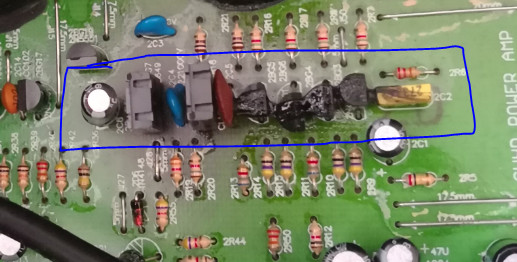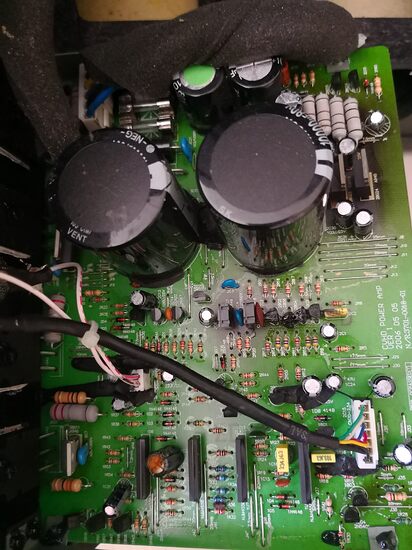My subwoofer had been making some annoying popping noises when it wasn’t receiving a signal lately which at first I thought was just interference from the washing machine. But after a while it got worse to the point where it was constantly making noise. So I took it apart and found some burnt our components on the amplifier board.
I don’t know that much about electronics but these are all large through hole components so it shouldn’t be too hard to replace them. But do you think it’s fixable? As far as I can tell it was still working to some degree before I took it apart, but I haven’t tested it after taking it apart so maybe not. There was some pieces of foil on the board that I think a mouse had brought in (I also found a dead mouse in there) which may have caused a short. If I can find a repair shop locally I might take it in but if it’s something that’s easy enough to do myself then I’d rather save the money and do that
I have a multi-meter but I don’t really know what I’m doing. Obviously that capacitor is dead and I assume it’s the mosfets or whatever they are that are burnt out but I have no idea how to test them. So any advice would be great.
First of all, can you source a replacement board, and if so for how much? It may be cheaper than ordering the individual components to replace it.
If you decide to try to repair the board. The pcb looks fine, a little charred, but it will be fine. you should perform a continuity test on the traces on the backside of the pcb as those could have been damaged with heat. Also bear in mind that other components (transistors or FETs) could be damaged internally. Furthermore there is a reason why those components got that hot in the first place, high supply voltage is my guess. This also looks like a single layer pcb so be careful not to damage the pads when removing the components as traces can come off the pcb very easily with single layer pcbs. I would say that you need to be at least proficient in soldering to attempt this repair.
Good Luck 
Edit: Also I should mention that this damaged board is MOST LIKELY a symptom of the real problem, it is very rare for this level of damage to happen from a single faulty component.
I wasn’t able to find a board for this model but the ones I found for a similar model were way to expensive, like half the cost of a new subwoofer.
I can probably find someone who’s better at soldering than I am (well that’s won’t be hard but someone who knows that they’re doing at least) But I’m nit sure how to figure out what’s broken and what’s okay. I’ve had a poke at it with a multimeter but I’m not sure if continuity is the right thing to check for some components.
Those parts are fairly easy to remove… just remember dab a tab of solder on your connections before attempting removal. It blends in with the high temp solders and removes it. I bet there is less then 10$ in parts on that, and if you recycle like I do … you might have a drawer of those parts already. As far as worth it… well time, parts, age of the amp, you might be better off buying a new one; however, if you are into the project then fix it up.
3 Likes
Before doing any work, make sure you can get replacement components. Else it will be a lot of work for nothing.
1st picture looks like power supply (because where else would you find 3 or 5W resistors?), might be wrong though.
3rd picture looks like heat damage.
4th picture looks like the capacitor just aged and failed.
Old solder is harder to remove. Definetly add some new solder.
looks like to me the first picture is npn transistors?
on the second picture it looks like a burnt resistor… if this is the case… It was probably the source cause .
and ya that capacitor is aged well. at least it isnt all spider web explosion. Should be able to get numbers off that anyways.
I’m pretty sure this was caused by a short. There were pieces of foil all over the board and on the second picture where the wires (or whatever they are) at the bottom of the picture are there was definitely a piece of foil contacting two of them.
Does anyone know of a guide or something for how to test components? Because I only get continuity on some things and on other I assume I’m supposed to be looking at ohms or someting
when i mentioned resistor I was referring to the reddish one left of the pair of 28024 mosfets.
As I don´t see any traces suggesting a dedicated controller, I would assume those are voltage regulators.
Could be power transistors, but then there would be some heatsink attached to them.
That is a zener diode, used to hard limit voltage.
Without a service manual, there isn´t much you can do except replace components. BTW: What model from what brand are we looking at?
From looking at it, all of these need to be replaced.

And these two could do with some heatsinks. The whole area has a blackened PCB (heat from the regulators and resistors).

right you are… didnt realise I could click and zoom in on pic… sure beats squinting.
1 Like
It’s a Cerwin-Vega XLS-12S subwoofer.
That black gunk on top is just glue or something, there’s more all over the board, if that’s what you mean
Yup, that is some silicone based glue. Can leave that untouched.
MazeFrame is correct about that list of parts need replacing… the other thing is… the resistors maybe over heated during the breakdown process, which might cause further issues as well.
you will want to use the continuity to test the actual traces to make sire that they are not damaged from the heat, probe from one end of a trace to the other and use resistance mode you should see no more than 1 to 2 Ohms, do this for each trace that passes through the “burnt” area of the pcb. As for testing the actual components, you cant, not really. The only way to test even a simple resistor is to remove it, read the value on the component and test it with a dmm.
after its all said and done you may be better off just buying a new amp as you mentioned that this is for a subwoofer, you can just extend the wires for the speaker outside of the enclosure and just get an external amp
3 Likes
I know a guy on ebay that does this for a living, restoring amps all day. It’s in his user name too, Amplifier_Surgery, you can ask him for advice maybe. Good luck.
1 Like
Thanks everyone for the help, I might still have a crack at it or get someone to look at it but in the meantime my dad has an amp I can have so I’ll see how it goes just wiring the speaker in to that.
2 Likes







